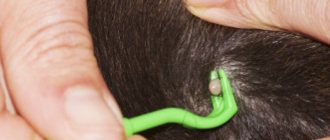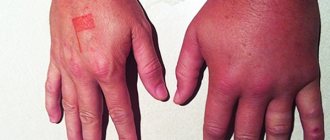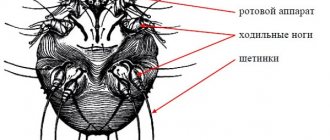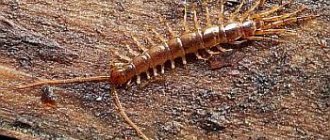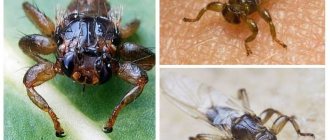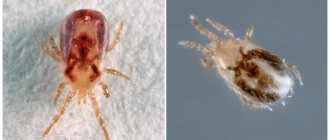Forest tick: how to recognize the threat
The forest tick is the most dangerous and aggressive species; it feeds on blood. Its bite can cause serious harm to the human body. Lives in forests and park plantings, attacks both people and animals. In winter it hides in the ground, tree cracks and fallen leaves, but with the onset of a thaw it comes out to hunt. The active season for ticks begins in the spring; it is during this period that people are most at risk of catching the parasite. Tick season lasts from spring to fall.
See the page: Ticks in the Moscow Region, especially dangerous areas are described there.
The tick resembles a tiny beetle, its body length is only 4 mm, has 4 pairs of legs, and is covered with a shell on top. Since the arthropod is very small, it is very difficult for a person to see its head and blood-sucking proboscis without special devices. Although the forest tick does not have eyes, it can smell its prey at a distance of up to 10 meters, thanks to its well-developed sense of smell. The male's body is smaller than the female's. The female, having drunk blood, can reach up to 2 cm in diameter; she is able to drink blood 10 times her own weight.
Photo of ticks - female on the left, male on the right.
Many people are afraid that a tick may fall from a tree and burrow into the scalp or neck, where it is very difficult to detect instantly. It is a myth. The forest tick does not rise above 50 cm from the ground, so this possibility is excluded. Often, a tick waits for a warm-blooded creature in the grass or on a bush, and when it comes closer, it grabs it with its front paws and climbs up quite quickly. The parasite travels throughout the victim’s body, choosing the most convenient areas with access to blood (most often the stomach, groin, neck, armpits). Then it digs into the skin, cutting it with its proboscis, and begins to suck out the blood.
What does a tick look like on the body?
After a tick has bitten a person, it can penetrate partially or completely. Since the parasite is small in size, after attaching its proboscis to the skin, it can be practically invisible. But as the insect’s body fills with blood, its body increases significantly.
This is what simple ticks look like on the human body:
A tick that did not bite into the skin
Having drunk blood, the tick has a light brown or red-brown color, the shape resembles a grain of corn. It is worth noting that males are slightly smaller than females; the latter, before detaching from the skin, manage to lay eggs.
Tick drunk on blood
Ticks living in Russia are found in deciduous parks, forests, garden plots and pastures - where there are plantings. The average size of a tick is up to 0.5 mm; it is rare to find larger individuals reaching 3 mm.
The body of the tick consists of six pairs of appendages and two parts: the most anterior ones are claws, forming a piercing-cutting mouth, a pair of pedipalps and 4 legs.
During contact with the skin, the parasite injects an anesthetic substance, preventing the victim from feeling the moment of the bite, during which time the pest manages to drink blood. Only after a third of an hour can a person see redness at the site of the bite, which is often itchy and itchy.
After drinking blood, it can fall off on its own, which indicates that the parasite is a male. The female, on the contrary, the longer she drinks blood, the more she crawls under the skin with her proboscis and head, which further complicates the extraction process. The female's body increases significantly.
Signs of a tick bite, symptoms and consequences
Each body reacts differently to parasites. Some people have an allergic reaction, while others may not even have a trace. Possible signs of a bite in a person:
- redness, itching;
- increased body temperature;
- the appearance of headache;
- lowering blood pressure;
- cardiopalmus;
- the appearance of skin rashes;
- enlarged lymph nodes;
- constant feeling of weakness.
The consequences of the attack depend on whether the parasite is infected or not. The most dangerous thing for humans is the bite of an encephalitis tick.
The consequences of such a bite are extremely severe (in case of infection and refusal of treatment):
- paralyzes the body;
- breathing problems occur;
- brain activity decreases;
- Possible death.
If a person has suffered from a “sterile” tick, then the complications may not be so dangerous:
- suppuration of the affected area;
- the occurrence of an allergic reaction;
- the appearance of edema, even Quincke's edema is possible.
Svetlana Tolstova
Infectious disease specialist, therapist with 15 years of experience in a city clinic.
Ask a Question
It is impossible to independently determine whether an infectious tick has embedded itself or not. Their appearance and color do not depend on whether they are infected or not. If you are bitten by an infected tick, prompt treatment can save the victim's life.
How long does it take for symptoms of a tick bite to appear in humans?
The first symptoms appear after 2-3 hours in the form of redness of the skin. After a week or later, the symptoms described above may appear.
Signs of a tick bite
Most often, an embedded tick can be detected visually. No other parasite adheres so tightly to the skin or has the same appearance, so it is very difficult to confuse it with anyone else.
The feeding parasite grows quite quickly in size, and its swollen abdomen is clearly visible and dark gray in color.
If it has already fallen off, then the wounds after a tick bite can be identified by the following signs:
- redness of the skin area;
- large, deep wound, often with bloody discharge;
- compaction and swelling of the area around the bite site;
- long-lasting swelling.
Similar marks may remain after the bites of some insects, such as wasps. But these arthropods do not hide, but, on the contrary, try to scare a person, so their attack is accompanied by severe sharp pain.
If marks appeared, but there were no painful sensations, then, with a high degree of probability, it was a tick.
We figured out what the bite itself looks like, but the symptoms after a tick bite can be not only visual. Many people react very sensitively to parasite saliva and mechanical damage, so allergic reactions may develop.
The most common symptoms of a tick bite:
- temperature increase;
- itching and skin irritation;
- weakness and headache;
- cardiopalmus.
After these signs appear, if there are no other prerequisites for a change in physical condition, you need to carefully examine the body or ask another person to do this in order to correctly determine the cause.
How is a tick bite different from other insect bites?
How to find out which insect bit and left characteristic marks on the skin? There will be only one spot, there will be no similar ones in the neighborhood, the redness will increase every hour, and an allergic reaction may occur. Bedbugs, for example, bite in several places at once, and fleas too. The bite of a mosquito and midge is much smaller than that of a tick.
Is it true that ticks do not bite all people?
It is known that mites react more to people who smell stronger. Therefore, ticks more often attack men, since their metabolism is more intense than that of women. In addition, a man’s body emits more heat radiation, exhaled carbon dioxide, ammonia and some other signaling factors that ticks recognize. There is an opinion that ticks do not like the smell of alcohol, so they do not attack drunk people. It is a myth. No such patterns have been documented.
Another interesting “fact” circulating on the Internet, that ticks only bite people of a certain blood type, also has no scientific evidence.
Interesting research on this topic was carried out by specialists from the Institute of Cytology and Genetics of the Siberian Branch of the Russian Academy of Sciences, which can be found on the website of the newspaper mk.ru
Why do ticks drink blood and how much do they need?
Ticks drink blood in order to get enough and leave offspring. Females will not be able to lay eggs in a hungry state; they definitely need blood.
How long can a tick suck blood? From several minutes to several hours, and females, as a rule, stay on the victim’s body longer. It should be noted that most of the time the tick is on the skin of a person or animal, looking for a place to suction, so if the tick has not yet latched on, you need to brush it off as soon as possible (no need to squash it on yourself like a mosquito, you can get an infection under the skin) . On average, an adult sucks blood for 1-2 hours, after which it disappears.
What happens to a tick when it drinks blood?
The tick drinks blood for several reasons, usually to continue development, replenish reserves in the body, and procreation. After a bite, the animals do not die, but continue to exist.
For example, tick larvae wait for their prey in the soil. They need blood to transform into nymph, the next stage of a tick's life.
Adult males and females behave differently after being bitten and fed with blood. The male falls off and dies after several copulations. This completes his mission.
A sexually mature female has one goal - to lay eggs. A fertilized individual will not be able to do this if there is not enough blood in its body, so the insects go on a “hunt.” After replenishing blood reserves, the female’s task is to get to the soil and lay eggs, which will turn into larvae. Thus, the circle is closed and the life cycle of the tick with the participation of new individuals is resumed.
How much blood can a tick drink at one time?
Hungry ixodid ticks weigh from 2 to 15 mg, and saturated ones from 200 to 1200 mg, which is many times their own weight. In one bite, a tick can pump out up to 1000 mg of human blood. The size of a hungry tick does not exceed 4 mm, and a well-fed one can reach 3 cm, becoming similar in size to a corn seed.
The photo compares two ticks on a cat’s body – one that has recently been sucked on and one that has already drunk blood.
What does a tick bite look like?
Typically, if a tick latches onto your skin, it will remain there for several hours or even days. You will definitely feel it when you undress or take a shower. If you spent time outdoors in the summer, you need to inspect your body for ticks.
What to do if you come back from a walk and find a bite site on your body? It may not necessarily be a tick. Any bite can create redness and swelling of the area: goosebumps or other insects. In terms of pain, a tick bite does not differ from the bite of other insects. You could even say that a tick bite is less painful than the bites of other insects.
But you need to understand that if after a day the bite site not only turns red, but also has a clear shape with a red rim, this is what a typical tick bite looks like on the human body. In fact, a person has 2-3 days to see a doctor after being bitten by an encephalitis tick to prevent the spread of the virus and maintain their health.
You can look at pictures of encephalitis tick bites in search engines. They all differ from each other, since the course of the disease depends on the person’s immunity. The better the immunity, the less the visual reaction.
There is also the possibility of an additional rash, a reaction to an insect bite. This is an individual reaction to a tick bite, which may not necessarily mean that you are infected with the virus.
What to do if you find a tick on your body or on the body of an animal
Be careful, if you feel a tick bite in a certain area, ask your friends to remove the tick correctly. Do not douse the tick with alcohol or other substances. You can’t twist it, you can’t squeeze the recruited body. Instead, it is better to take the thread and twist it into a loop. You can also use tweezers and grab only the head of the tick; do not squeeze the body. Hold the tick in such a way that you can pull it at an angle of 90 degrees. Place the tick in a closed container and take it with you to the hospital. It is easier for laboratory technicians to detect the disease in a tick than in the human body.
Bitten by a tick - Yodantipirin
Yodantipyrine® has a rapid effect on the disease and is prescribed by most doctors in Russian hospitals. It acts from the intestinal tract within a few minutes and begins treatment. The main task of the tablet is to reduce the abscess and stimulate the immune system so that it stops the virus and does not allow it to penetrate the cell. Yodantipyrine® is characterized by anti-inflammatory, interferogenic qualities. It is a rapid inducer of alpha and beta interferon and stimulates humoral cellular immunity.
It is necessary to understand that viral encephalitis is a very complex disease, the consequences of which cannot be ignored. Although the history of medicine has recorded many situations where a disease was dealt with without drugs, it is not a fact that you will be among the lucky ones. At first there will be redness of the bite site, then the temperature may rise to forty degrees. If you develop a fever, be sure to consult a doctor; you may have to go to the hospital, but you need to start treatment urgently. If this is not done, people can be paralyzed, blindness, hearing loss, and problems with the nervous system are also possible. A person can live with the virus for many years, and he can become completely dependent on other people.
Conclusion: the appearance of the wound after a tick bite is not a manifestation of encephalitis. Swellings can be small or, conversely, large. Only a blood test can tell if the virus has entered the body.
How dangerous is a tick bite for humans?
An attack by an uninfected tick is not fatal and is relatively safe for human health. Severe diseases can only be transmitted if the parasite has been infected with viruses or bacteria.
A tick can serve as a carrier of a fairly extensive list of diseases, so after removing the tick, it is better to save it for tests to determine infections (encephalitis, borreliosis, called Lyme disease), this is done in the laboratory at the infectious diseases hospital. It is worth noting that the presence of viruses in an insect does not guarantee that the bite victim will also get sick. It is necessary to examine the insect for peace of mind if the result is negative, and for timely treatment if the infection is confirmed.
The most commonly transmitted and pose a huge threat to human life are tick-borne encephalitis and borreliosis. Scientists have proven that the chance of becoming infected from a tick is unlikely, since 90% of ticks, according to research, are not infected. Although minimal, the chance exists.
Is it possible to get infected from a tick if it crawls across your body?
If a tick simply crawls across the surface of the skin, it is impossible to become infected from it. The first stage of infection begins precisely from the moment the tick suctions and injects an anesthetic substance under the skin. So if a tick is crawling on you, brush it off as quickly as possible and, if possible, kill it with fire.
What does a tick look like?
Today, the tick population numbers 50 thousand species. 20% of the family members are carriers of dangerous diseases, that is, every fifth bite is committed by an infected individual. An encephalitic (or borreliosis) tick is visually no different from an uninfected tick. Ixodid ticks - the most dangerous to humans - are almost identical in appearance:
- The average size is 4-5 mm if the tick is hungry. After saturation, the sizes increase;
- Flat oval body;
- Color – yellow, brown, black (if the individual is hungry); pinkish or gray (if the individual is full);
- They have 4 pairs of legs, and not 3 like other insects with which they can be confused;
- The body consists of a torso and a small head. The size of the head is less than 30% of the size of the entire body.
- There is a proboscis on the head with which the tick attaches itself and sucks blood.
Gradually becoming saturated, the pest increases in size and can reach 3 cm. By how much it has grown, you can judge how long ago the tick was attached.
Bitten by a tick - what to do: first aid
If a tick is crawling on you, shake it off immediately, and if it has already attached itself, remove it as soon as possible and store it in a jar with moistened cotton wool or blades of grass to deliver it alive to the laboratory to test for infection.
Treat the wound with an antiseptic. If signs of an allergy are observed - severe redness and swelling of the bite site, immediately give the victim an antiallergic drug. You can purchase the drugs “Zyrtec”, “Suprastin”, “Prednisolone” (spread on the damaged area): the dosage regimen of the drugs is individual. The effect of one tablet is enough for a whole day. These antihistamines are actively used to eliminate allergic reactions. Taking the tablet is not recommended if you are hypersensitive to the components. Hypokalemia, sleep disturbances, flatulence and negative nitrogen balance may develop.
Svetlana Tolstova
Infectious disease specialist, therapist with 15 years of experience in a city clinic.
If the encephalitis virus has entered the human body, the drug Ribonuclease is prescribed for treatment. The medicine is administered 6 times a day intramuscularly, in a hospital setting. The dose is prescribed by the attending physician. The use of Ribonuclease is not recommended for respiratory failure, tuberculosis and bleeding. There is a risk of developing allergic conditions. Do not use the drug without a doctor's prescription!
How to remove a tick?
Do not pull, twist, or try to crush the parasite with your bare hands - the body of the tick is easy to damage, often the head comes off and remains under the skin, and this is dangerous - toxins continue to enter the human body, and suppuration begins. The body of the tick must be taken with a special tool; it is best to seek help from a doctor. If you have already touched the parasite, do not touch your eyes, mucous membranes of the nose and mouth (until you have disinfected your hands). If the nearest medical center is far away, you should not do nothing either - while the tick’s proboscis is under the skin, it continues to poison the body.
In this case, carry a Mite Card with you - a lightweight and compact tool that will help remove the parasite quickly and safely. The KleshKart fits in your pocket or wallet, you can put it in your smartphone case and easily carry it with you everywhere.
How to remove a tick?
The arthropod parasite attaches itself very firmly to the human body, since the tick's saliva acts like glue. The proboscis digs deep into the skin, so removing the tick must be done very carefully. Stores (usually pet stores) now sell convenient tools for twisting ticks.
Step-by-step recommendations for removing a tick:
- Using counterclockwise movements in a circle, as if unscrewing a self-tapping screw, pull it out of the skin using tweezers. Be careful that the head of the tick does not come off.
- If you had to remove the bloodsucker in nature, and there were no tweezers nearby, an ordinary thread will help. With its help, the proboscis is tied near the very surface of the skin and pulled out with light jerks.
- After removal, you need to make sure that the tick is intact, put it in an airtight container and deliver it to the clinic for analysis as soon as possible.
- Lubricate the surface near the bite with any antiseptic.
Svetlana Tolstova
Infectious disease specialist, therapist with 15 years of experience in a city clinic.
People often advise treating the affected area with oil, kerosene, gasoline and other liquids so that the tick comes out on its own. This action is wrong - the tick will try to dive even deeper under the skin. But if the insect crawls out after this, its body cannot be examined in the laboratory.
What to do if the tick head remains under the skin?
The tick's head may remain under the skin if it is removed carelessly or too quickly. It looks like a small splinter, so some people are negligent about removing it, saying “the tick is dead, it no longer sucks blood, it will fall off on its own,” or they simply don’t notice. But this is not recommended. Remaining under the skin, the tick's proboscis will provoke inflammation and suppuration of the wound. Therefore, do not leave the head or proboscis of the tick under the skin, waiting for them to fall off on their own.
Take a sharp needle disinfected in alcohol and pick up the remaining proboscis and remove it. After a bite, a small wound will remain on the skin, which will heal quickly if the tick was not infectious. Treat the bite site with peroxide, then brilliant green or iodine. If the tick bite area is very itchy, use Fenistil Gel or a similar itching reliever. Try not to scratch the inflamed area to speed up the healing process.
To prevent the head of the tick from remaining under the skin, catch it as close as possible to the suction site
First aid for tick bites
At home, of course, it is impossible to determine which tick bite is dangerous and which is not, therefore, first of all, we remove the embedded parasite. This is easiest to do if the tick has just begun to penetrate and has not had time to penetrate deeply. In any case, it must be removed immediately after detection.
It is most convenient to use surgical clamps or tweezers. The tick is grabbed as close to the mouthparts as possible and twisted out of the wound with gentle rotational movements.
It should not be abruptly pulled out or grabbed by the abdomen, as this will lead to rupture of the body and the front part is guaranteed to remain under the skin and will subsequently be extremely difficult to remove. The remains of the parasite will cause severe inflammation and suppuration of the wound.
Advice on applying oily substances to ticks is absolutely useless. Yes, after some time the parasite will die due to blockage of the respiratory openings, but it will not fall off and will still have to be removed.
After removing the parasite, the wound is treated with whatever antiseptic agents are on hand, for example, iodine or alcohol.
With proper treatment, tick bites heal in about a week. Under no circumstances should you pick at the wound with non-sterile sharp objects, or burn it with burning coals or hot metal, as some “experts” advise. There is no practical benefit from this, but these “first aid” methods can very easily cause suppuration or infection.
IMPORTANT!
If you cannot remove the tick yourself or the front part of it remains under the skin (and it looks like a small black dot), it is better to contact the nearest medical facility for qualified assistance.
The removed tick must be placed entirely in a small bag or tightly closed container and sent for infection testing. This will help in correct diagnosis and early treatment in the presence of pathogens of some dangerous diseases.
What disease can you get from a tick bite?
After a tick bite, a person develops various ailments - from ordinary irritation to severe or fatal illness:
- Tick-borne encephalitis: at first the disease resembles a common cold. The incubation period can last up to a week. No analysis will provide one hundred percent information about the infection if 10 days have not passed since the attack. To make an accurate diagnosis, you need to bring a live and unharmed parasite for examination. More information about encephalitis is on Wikipedia.
- Borreliosis (Lyme disease): This disease can be transmitted to humans if the tick contains Borrelia bacteria. Symptoms do not appear immediately, after a while the lymph nodes become enlarged, the body aches, and a red ring appears on the skin as in the photo. Read more about the disease on Wikipedia.
Tick bite mark indicating Lyme disease infection
Modern drugs can completely cure infections that are transmitted by ticks, provided they are detected early and treatment is started immediately.
Consequences of a tick bite
Unfortunately, a tick bite can cause more than just allergies in a person. Infection with pathogens of certain diseases can lead to the most serious consequences. Of course, not every parasite is truly dangerous, but this possibility cannot be discounted. The fact is that using several hosts as a food source during their lives, ticks are carriers of pathogens of natural focal diseases:
- encephalitis;
- anaplasmosis;
- ehrlichiosis;
- borreliosis (Lyme disease).
Anaplasmosis and ehrlichiosis have a varied clinical picture, depending on the general physical condition of the victim and the extent of the lesion. The incubation period ranges from 1 day to three weeks
. At this time, fever, nausea, vomiting, cough, diarrhea, intestinal pain, and skin rashes may occur. In severe cases of the disease, death is possible. The diagnosis can only be confirmed in laboratory conditions.
Borreliosis is a common disease in our country that is transmitted by ticks. Pathogens - bacteria from the genus Borrelia at the first stage cause fever, headache, and weakness.
At the initial stage of development, the disease can be successfully cured with antibiotics. In advanced cases, an infected person faces disability or even death.
The most famous disease caused by ticks is encephalitis.
It is because of this that all ixodid ticks are often called encephalitic.
The main danger of encephalitis is damage to the central nervous system by viruses.
At the same time, individual pathogens can affect different parts of the brain and spinal cord.
The clinical picture depends on the location of the pathogen and the period of development of the disease. The incubation period can last from one day to a month. Among the most common symptoms are a sharp increase in temperature, disturbances in nervous activity, digestive disorders, mental disorders, headaches, hyperactivity or lethargy and drowsiness.
Encephalitis is the most common cause of disability and death among all tick-borne diseases.
Of course, not every tick carries these serious diseases. In order for the pathogen to enter the body of the parasite, a natural focus must exist. For example, encephalitis is more common in the Urals and east of it, in taiga zones, and borreliosis is quite common in the European part of the country. However, isolated cases of tick-borne encephalitis are periodically recorded even in the Moscow region, so the potential danger always exists.
Signs of infection with tick-borne encephalitis
According to doctors, symptoms of encephalitis are detected after 10-14 days from the moment of tick bite. What to do? There is no need to panic; often elevated body temperature and muscle pain can be a manifestation of the body’s protective psychological response after fear and anxiety.
Once the disease begins, it goes through certain stages:
- Unreasonable and short-lived chills, increased body temperature up to 40 degrees. According to the clinical signs of the formation of encephalitis, this period is more similar to influenza infection.
- After some time, the patient may experience symptoms: nausea and vomiting, attacks of severe headache. At this stage, all symptoms indicate a gastrointestinal disorder.
- After a few days, the patient suddenly develops symptoms of arthritis or arthrosis. The pain in the head goes away and is replaced by aches throughout the body. The patient's movements become very difficult, and breathing problems arise. The skin on the face and body becomes red and swollen, and purulent abscesses appear at the site of the bite.
- Further, the symptoms only worsen, because the infection enters the patient’s circulatory system and begins its destructive work. Delay can lead to death!
If an embedded tick is found on the body, it should be pulled out immediately. You can do this procedure yourself or go to the hospital. Health workers can easily remove it and run a series of tests. Only in laboratory conditions can one accurately determine whether this tick is dangerous. If treatment is necessary, you must unconditionally follow the recommendations and instructions of the attending physician so that the effectiveness of the treatment is maximum.
How to identify relapsing fever by a red spot on the skin?
You can also become infected with tick-borne typhus from ticks. In addition to the spot, the following symptoms appear: photophobia, undulating fever, low blood pressure, muscle pain, nausea and vomiting, numbness, itching at the site of the bite, problems in the functioning of internal organs (kidneys, spleen, liver).
What does a spot on the skin look like with relapsing tick-borne typhus?
The incubation period is 5-15 days. Redness appears at the site of the bite, and then a purple papule forms, surrounded by a hemorrhagic ring up to 30 mm in diameter. The ring turns pale and disappears within 2-4 days, and the papule turns pink and can last up to 4 weeks. There is usually severe itching, and scratching can cause ulcers that take a long time to heal.
Treatment of tick-borne encephalitis
If the diagnosis is confirmed, the doctor recommends comprehensive treatment to the victim. In the acute stage, strict bed rest with intensive therapy is prescribed, which helps reduce the amount of toxins in the body and weaken the active virus.
The victim is also injected intramuscularly with the drug “Gammaglobulin”. The sooner this serum begins to act, the faster the patient will experience improvements. The effect of the drug lasts for a day, after which the body temperature normalizes, the signs of encephalitis and meningitis decrease, and then completely disappear. To alleviate the signs of poisoning, you need to introduce fluid to restore electrolyte balance, and also start taking glucocorticoids.
Do not use the drug under any circumstances unless prescribed by a specialist!
Where can I take a tick for analysis? Moscow laboratories
Listed below are laboratories where you can submit ticks for analysis in Moscow and the Moscow region; they conduct tests for encephalitis, borreliosis and other infections.
- FBUZ "Center for Hygiene and Epidemiology in the City of Moscow": metro station Alekseevskaya, Grafsky lane, building 4 (entrance from the yard, 2nd floor). Telephone
- Branch of the Federal State Institution "Center for Hygiene and Epidemiology in Moscow": metro station 1905 Goda Street, Krasnogvardeisky Boulevard, building 17 building 1. Telephone: 8 (499) 256-24-40
- Institute of Poliomyelitis and Viral Encephalitis: Moscow Region, Vnukovo, Moskovsky village. Telephone
- Children's Clinical Hospital No. 13 named after Filatov: metro station Barrikadnaya, Sadovaya-Kudrinskaya street, building 15. Telephone
- Infectious Clinical Hospital No. 2: Sokolinaya Gora metro station, 8th Sokolinaya Gora Street, building 15. Telephone
If you are afraid to remove the tick yourself, go to the emergency room, where they will professionally remove it and treat the wound. There you will also find out which laboratory the tick can be taken to.
Vaccination against tick-borne encephalitis
The most reliable method to avoid diseases transmitted by ticks is to get vaccinated against tick-borne encephalitis on time. It is especially recommended for people living or working in an unfavorable tick-infested region or near a forest.
It is recommended to get vaccinated in the last months of autumn. But there are also immediate vaccination options for emergencies. During the warming period, vaccinations can also be done, but after the injection, a person should not be in places where these arthropods live for a month.
The protective effect of the vaccine will occur only after the specified time has elapsed and the entire course has been punctured. Then you can follow the plan and get an injection once every 3 years. If more than 5 years have passed between vaccinations, double vaccination is repeated.
